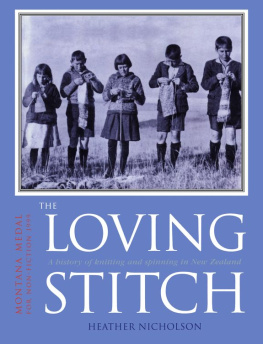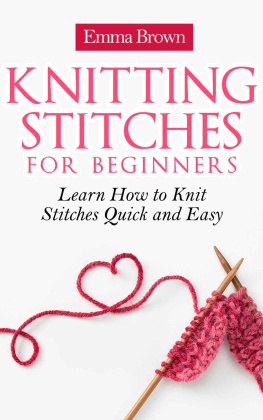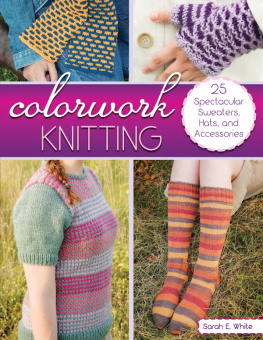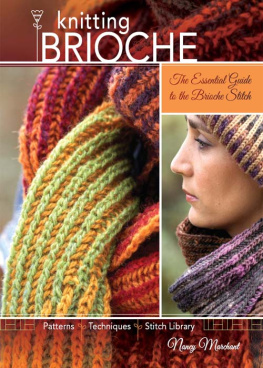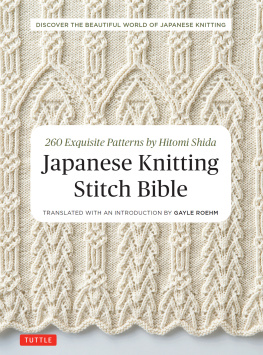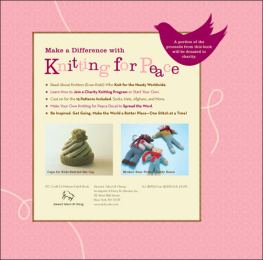Dedicated to the memory of my mother, Amy, who was a great knitter, and to my daughters Ruth and Jessica, who are not.
A great many people have made this book possible, too many to list individually, but my heartfelt thanks go to all. Over 600 women and men generously contributed their family knitting stories along with cuttings, pattern books and knitted articles, some of which were saved from the tip, while others were carefully cherished family treasures and memorials to past knitting exploits. A lively personal correspondence is still maintained with a number of contributors, including Kaye Cossar-Stokes, Yvonne Featherstone, Jillian Johnstone, Marjory McDonald-Walker, Loris Mathew, Jean Smith and Noeline Thomson.
My gratitude also goes to members of the yarn-making and retail trades, including Peter Chatterton, Jimmy Clement, Went Ferdinands, David Little, Neil and Shirley Goodman, Peter McDermott, Peter Williams and Peter Stapleton, who have provided much information. The history of the woollen textile industry in New Zealand from sheep to shop deserves a much more detailed treatment than can be given here. Little progress could have been made in the project without the expert help of librarians and curators in museums, historic houses and libraries in New Zealand and Britain. I thank them all for their professionalism and the lengths to which they go to assist researchers and am especially grateful for regular help over the last few years by staff of the Alexander Turnbull Library, the Auckland Institute and Museum Library and the Auckland War Memorial Museum. Grateful thanks also go to the many woolcrafters who shared their expertise, and particularly to Jay Venables for her ongoing interest and support.
The Queen Elizabeth II Arts Council awarded a short-term study grant, which helped me to study historical knitwear in Britain during 1990. The 1993 Suffrage Centennial Year Trust Whakat Whine made a generous grant, which greatly assisted research into how ordinary New Zealand women served their families with their loving stitches. The Vernon Wiley Trust and Historical Branch of Internal Affairs provided grants to assist in covering the costs of publication.
Coral Atkinson and then Anna Rogers supplied enormous amounts of faith and encouragement, along with firm editing and reorganisation of the original rambling text.
Special thanks go to Ian, Ruth and Jessica for their continuing support and patience.
Note: In 1994 I produced a photocopied family edition of the original manuscript called Look Back in Stitches which contains much extra material not included in this book. Copies are in the Auckland Museum Library, the National Library and the Hocken Library as resources for others researching domestic and textile history. The pattern books, knitted articles, tools, letters and anecdotes are now in the care of the Auckland War Memorial Museum.
T his New Zealand story of the craft of knitting is a celebration of our Anglo-Celtic heritage. In our enthusiasm for multiculturalism it is sometimes forgotten that, as New Zealanders, those of us with northern European roots have our own traditions and a culture that is quite distinct from the old country, wherever it may be. This account tells us something of the lives of ordinary women and men, and the impact on them of such outside events as war, depression and growing affluence.
Because little is recorded about our domestic lives, building the story was laborious. The result is an assemblage of hundreds of fragments of published information, as well as anecdotes and memories contributed by knitters themselves.
The project became expensive, and several grant applications were turned down so it was with astonished delight and gratitude that I learned that the 1993 Suffrage Centennial Trust had approved my application. The distribution of Suffrage grants did not please everyone,
Hand knitting was introduced to Northern Europe about 600 years ago. Since then, by far the greatest volume of hand-knitted socks, stockings, mittens, gloves and caps was made for economic reasons: to clothe family members, or for sale. The fact that hand knitting can be done at the same time as another task made it a valuable skill for both townsfolk and cottagers.
Although textile manufacturing had long been industrialised, nineteenth-century immigrants from Britain and Europe brought with them a variety of practical clothing skills, including sewing, spinning and knitting traditions. At the same time, decorative knitting and embroidery, just like sports activities, were turning into leisure time-fillers for the new middle classes. Before then, much fine needlework was done to provide clothing, upholstery and draught-stopping hangings, while traditional local specialties such as Shetland lace, Irish crochet and Assisi work were invented by philanthropists to provide a means for poor peasants to earn money.
Until quite recently, most New Zealand women economically knitted and sewed much of their families clothing. None of this productive leisure work has been recorded as part of our nations GDP. Instead, the homely image of the housewife occupying her spare moments with her knitting needles and wool has often been made an object of fun.
Our unpretentious but practical and loving craft has left few traces. When elderly women die, their collections of patterns and humble knitting tools are sent to the op shop or are dumped. There are few samples of everyday garments to show for all those loving stitches of the past. If outgrown childrens clothing was in good order, we briskly passed it on to others because there was no space to store it. Unwanted plain garments were unravelled and the yarn reknitted. Old jerseys were cut up to stuff quilts and cushions or they just wore out and the fibres collapsed. Moth grubs demolished wool; sunlight and dampness rotted cotton counterpanes.
Home-knitted and sewn garments were once far cheaper than made-up garments. This helped to keep consciences quiet in the days when many women thought they must not be caught sitting down doing nothing, or worse, doing something they enjoyed. Knitting was usefully disguised as an essential task while it gave women a break from trudging between kitchen sink, stove and wash-house. Todays hand knits, though, compete with cheap, well-constructed machine made knits and easily laundered sweatshirts and machinery imitates complex hand-knitted fabrics. Nevertheless, women and some men still knit for family, charity, to earn, and as a creative activity that can be made as simple or as complex as wanted.
The Suffrage Centennial Trust recognised the role of knitting in the history of New Zealand women, but initially, the womens movement denounced traditional domesticity and all its works: for some years it was not ideologically correct for a career woman to be caught with her knitting needles. To gain status, women were supposed to abandon their customary skills and begin power dressing and jogging. Of those who took up feminist fibre art, many would have nothing to do with domestic crafts, except, perhaps, for those practised by various ethnic groups, and moved straight to conceptual fibre art on walls.

